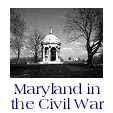Alternate Designations
History
Companies A., C. & D. were organized at Frederick City, and Company B. at Cumberland, Maryland, from August 10 to November 27, 1861. Company A. was called "Cole's Cavalry" after it's founder and Captain, Henry A. Cole. When organization was completed, these four companies were consolidated into a battalion, and Captain Cole was promoted to Major and given command of that battalion. The name "Cole's Cavalry" was then assumed by the battalion.
Most of the men in the original four companies of Cole's Cavalry were from Western Maryland; however, there were a number of men from Virginia and Pennsylvania as well. Most of these men were farmers and planters, young, unmarried, accustomed to the use of both firearms and riding, and most of them brought their own horses with them. Their extensive knowledge of Western Maryland, and the topography of the great Valley that runs through it from Pennsylvania deep into southern Virginia, and known in virginia as the Shenandoah, served as a great asset to the Union cause.
Companies A., C. & D. wintered along the Potomac in Western Maryland, Company B. wintered in Western Virginia. In January of 1862, when Jackson made his forced march through the snow down the Valley, Cole's Cavalry was among the meager defenders who held Hancock, Maryland, and checked Jackson's advance until a stronger Federal force arrived.
In March of 1862 Genral Bank's crossed the Potomac and proceeded toward Martinsburg, Virginia. On the 5th the battalion had a lively skirmsih with Confederate forces near Bunker Hill, and on the 7th, in a fight between Bunker Hill and Winchester they suffered their first casualties, one dead and two wounded, and Cole's horse was shot out from under him; but the rebels were driven from the field. On the 11th Williams' Brigade, to which the battalion was assigned, engaged Confederates at Stephenson's Depot, and on the 12th, as Bank's advance, made a cavalry charge into Winchester, capturing a number of prisoners. On March 2nd Williams' Brigade left Wnchester to join General McDowell's command in eastern Virginia, Co.'s A. & C. accompanied Williams, while Co.'s B. & D. remained with General Shields' Division. That very day Jackson attacked Shields at Winchester. Hearing the gun fire from behind, Companies A. & C. turned about and returned to winchester to join the other two companies in the battle.
Cole's Cavalry remained in the Shenandoah until September of 1862, at which time Lee began his first invasion of Maryland. Cole's command attempted to impede the Confederate advance. On September 2nd the battalion engaged a superior Confederate force at Leesburg. The command managed to push back the Confederate cavalry, at a severe cost; then fell back to Haper's Ferry.
Harper's Ferry was soon surrounded by Confederate forces under Stonewall Jackson. On September 14th, when it became apparent that it was the intention of the garriosn commander to surrender the garrison, Major Cole informed the commander, Colonel Miles, that he would not surrender his command. Miles then authorized any cavlary within the garrison to attempt a breakout if they choose to do so. That night, Cole's Cavalry, the 12th Illinois Cavalry, 8th New York Cavalry, Rhode Island Cavalry and 1st Maryland Cavalry, slipped out of Harper's Ferry, across the Potomac into Maryland, and through the Confederate lines. It so happened that his breakout put them between Jackson and Lee's forces who were concentrating near Antietam. Lee had earlier sent General Longstreet norht to investigate rumors of a Federal coulmn advancing toward the Confederate Army. The Federal cavalry column, while moving around Lee's flank encountered Longstreet's ammunition trains moving south to rejoin the main body of the Army of Northern Virginia. The cavalry was able to capture a large part of the train amd escourted it to Federal authorities.
In November Cole's Cavalry was assigned to 12th Army Corps, and was at the head of General Geary's Division as advance reconnoissance when the 12th began it's march up the Shenandoah in December. The battalion was engaged in skirmishes at Charlestown on the 2nd, Berryville on the 3rd and Winchester on the 5th. In mid month the 12th was directed to move east, but Cole's Cavalry was ordered to remain in the Valley. On the 20th a portion of the 12th Virginia Cavalry attacked the Marylanders in an attempt to drive them from the Valley or destroy them. But Cole had caught wind of the attack. He placed two companies on his flanks out of sight before the attack, and once it commenced, these companies came in on the 12th Va.'s blind sides. The Virginians were driven off, and their Commander, a Captain Baylor, who was wanted for violating a flag of truce, was captured.
The Battalion continued to patrol the Valley through the Spring of 1863, skirmishing with partisans. On June 13th, in pursuit of Confederate Cavalry, Cole's Cavalry stumbled into the advance of General Rodes' column as it advanced toward General Milroy's position at Winchester. Maryland scouts slipped through the Confederate lines to warn Milroy. After Milroy was driven from Winchester, Cole's Cavalry provided a rear guard for the fleeing Federal troops who managed to break out of Winchester. Cole then took the offensive. Hanging on Rodes' flanks, he cointinually staged hit and run raids on the Confederate column as it marched north. When not engaged in raids, Cole's Cavalry provided reconnoissance for the Federal Army as it sought out Lee's army. During the Gettysburg Campaign, the battalion fought at Martinsburg on June 11th, Berryville on the 13th, Williamsport the 15th, Catoctin Creek, Maryland,,,, on the 17th, Frederick City June 22nd, Fountain Dale, Pennsylvania and Gettysburg on July 1st, Emmitsburg, Maryland on July 5th, and at Harper's Ferry and Falling Waters on July 6th. During this period they not only captured a large number of enemy soldiers and supplies, they also captured Lee's dispatch rider who was to inform General Ewell to concentrate at Gettysburg; and most significantly they burned the pontoon bridge Lee had had built across the Potomac south of Hagerstown.
During the months which followed the Battle of Gettysburg the battalion rested and recruited to refill it's depleted ranks. Then on September 14th the battalion surprised and captured much of a Confederate company of Cavalry near Leesburg, Virginia.
On October 18th, General Imbodden and Harry Gilmor's Maryland Battalion of Partisan Rangers successfully attacked and defeated a large portion of the garrison at Harper's Ferry. Among the units sent to the relief of the arsenal, Cole's Cavalry suffered severe losses throughout a day long engagement. In December the battalion participated in a raid into the Shenandoah towards Staunton. For fifteen days the cavalry roide through grueling winter weather and suffered greatly for it.
When the raid was over the battalion returned to it's winter quarters on Loudon Heights, over looking Harper's Ferry. On numerous occassions Cole's Cavalry had crossed swords with Mosby's Rangers. Mosby, learning that Cole's exhausted men had returned to their camp, resolved to drive them for ever from Virginia. He led his command to within several miles of Loudon Heights, then his men advanced on foot leading their horse through the snow, until they were hidden in the woods outside of Cole's camp. Without warning Mosby attacked the sleepy camp. But his plans soon went airy. Cole's men, stumpling from their slumber into a blazing fire fight managed to put up a stout defense and drive Mosby from their camp. Mosby's losses were quite significant.
Later in the month the battalion marched into West Virginia to help repell Confederate raiders. On February 13th most of the men in the battalion re-enlisted for the duration of the war, marched to Frederick and enjoyed a well deserved 30 day furlough. Then the battalion began the process of recruiting new men to bring it's ranks back up to strength. During their recruitement, the battalion was assigned to General Franz Sigel's command and sent back into the Valley. Not fully reorganized, many of it's men without mounts or proper equipment, the battalion suffered significantly during Sigel's campaign.
When Sigel was replaced by General Hunter, the mounted portion of Cole's Cavalry marched with Hunter to Lynchburg, participating enroute in the Battle of Piedmont on June 5th, and skirmishes at Tye River Gap on June 12th, Lexington June 13th and Buchannon on June 14th. Hunter arrived at Lynchburg on the 18th and was driven by General Early into West Virginia. When Early marched north, the dismounted portion of Cole's Cavalry particiapted in the defense of Leetown on July 3rd. Remounted, partof this detachment was able to join up with General Wallace's small command at Monocacy. After the Battle of Monocacy on July 9th, Early moved on toward Washington, but eventually recrossed the Potomac back into Virginia. Cole's Cavalry participated in the pursuit and the Battle of Snickers Gap on July 19th.
In late July Early again crossed the Potomac into Maryland. His army crossed at various places to give the impression of a large scale invasion. The manuver was a feignt to draw attention away from the Confederate Cavalry column that streamed across Maryland to Chambersburg, Pennsylvannia. A portion of Cole's Cavalry engaged Confederate Cavalry engaged in this operation on July 26th, and participated in the pursuit of this column after it burned Chambersburg.
On August 5th Early again crossed the Potomac into Maryland, moved through Sharpsburg toward Boonsboro. Approximately half of Cole's Cavalry engaged the head of Early's column and was subsequently driven back, suffering heavy losses.
With the appointment of General Sheridan over a combined infantry and cavalry command directed to take control of the Shenandoah, Cole's Cavalry was assigned to Merritt's Cavalry Division, Tolbert's Cavalry Corps, and participated in the subsequent campaign to dislodge Early from the Valley. In the winter of 1864 General Rosser, C.S.A., led a raiding party into West Virginia to collect horses and forage. Cole's Cavalry was moved to West Virginia to protect the region. Subsequent attacks on the B & O Railroad in the winter and spring of 1865 by Mosby's Raiders, forced the cavalry command to remain in West Virginia until the end of the war.
Cole's Cavalry was mustered out of service on June 28, 1865 at Harper's Ferry. The cavalry command then rode to Baltimore to be formally discharged. It is estimated that the command rode over 7000 miles during it's four years in the saddle. Two officers and forty five men were killed in battle. Two officers and 120 men died of disease.
History provided by Gary Baker of the Association of Carroll's Sacred Trust.
Published Sources
See the General Sources page for items containing information on all Maryland Units.
Christopher Armour Newcomer, Cole's Cavalry; or Three Years in the Saddle in the Shenandoah Valley, Freeport, NY, Books for Libraries Press, 1970 (Reprint of Baltimore:Cushing and Co., 1895 edition).
Archival Sources
Reenacting Links
Something missing?
Suggestions of additional resources welcomed! Please send info to John Lamb .






